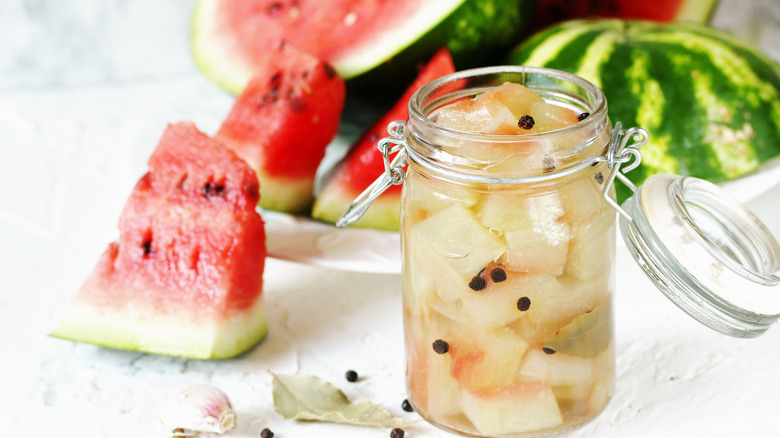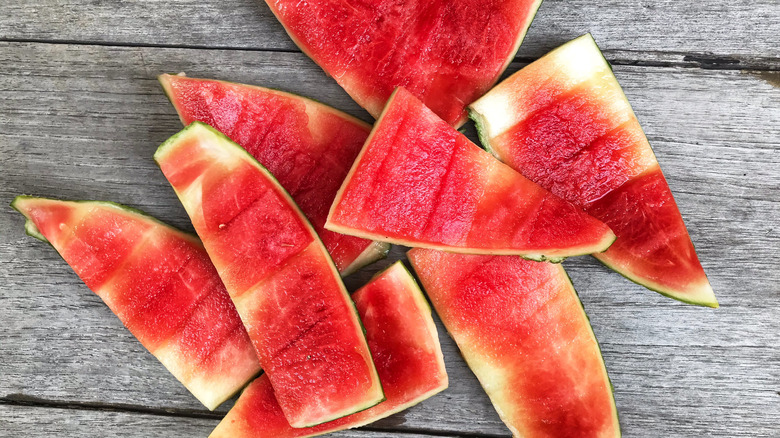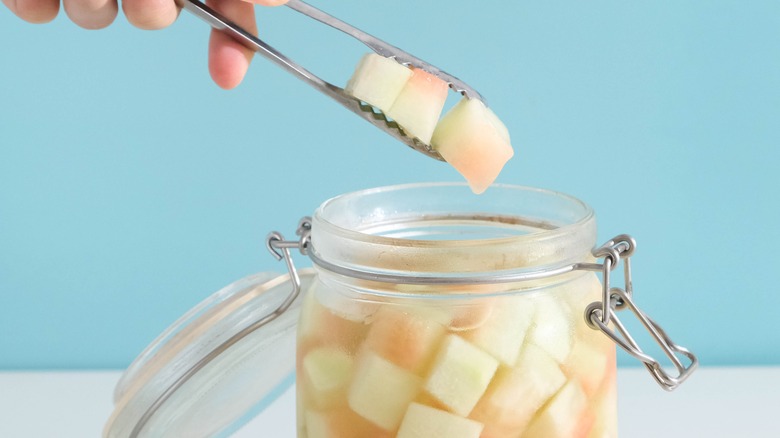Don't Toss Your Watermelon Rinds, Pickle Them Instead
Ever wondered if your watermelon rinds were meant for more? Well, this is the summer when you learn to put all of the melon to good use. Instead of throwing rinds in the trash, throw them in a jar instead and pickle them for a tasty treat. Skeptical? Don't knock this waste-free tip before you've tried it!
Pickled watermelon rinds are considered a delicacy in the Southern United States, and their unique sweet and tangy flavor makes it no secret as to why. You can include them in other summer dishes, let them chill and keep them until early fall, or dig into them right away on their own as a crunchy snack. Watermelon rinds are a secret superfood that are a great source of fiber, can boost athletic performance, and keep you hydrated on those hot summer days. They are truly the perfect addition to any summer meal, but best of all, pickled watermelon rinds are super easy to make.
Making pickled watermelon rinds
Pickling watermelon rinds is similar to how you pickle just about any vegetable, requiring minimal setup and ingredients. Give your watermelon rinds a thorough wash before peeling away the green shell, then prep your vinegar and water-based brine. After boiling it all together and carefully transferring it to an airtight jar, let your pickles rest at room temperature. Watermelon rinds typically rest for 24 hours before being transferred to the fridge to be stored for up to one month.
Cut your rinds however best suits your desired dish: slices for snacking, cubes for a salad, or spirals for a charcuterie board. Signature Southern recipes call for adding garlic, allspice, and peppercorn to your brine for a spicier flavor profile, but those with a sweet tooth may want to add cinnamon, mint, and more sugar. You can consult a guide to pickles to see what other combinations suit your fancy, and note that adding an extra dash of your spices right before sealing the jar will give your pickles more flavor.
Be sure to follow FDA and National Center for Home Food Preservation guidelines for pickling, which call for marking expiration dates on your jars. They say it's essential to refrigerate your rinds so the pickles don't spoil — if they're left unrefrigerated for more than a day, harmful bacteria could start to grow in the fruit. Additionally, make sure your jars are properly sealed, with no juice on the rim that could form air bubbles in which bacteria could grow.
More pro pickling tips
Pickling watermelon rinds specifically calls for using vinegar, because the acid prevents the rinds from spoiling prematurely and adds a tangy flavor to your pickles. Most recipes recommend apple cider vinegar which has a more sour taste, but distilled white vinegar is also commonly used in pickling due to its milder flavor. Granulated sugar is best used for pickling because of its melting properties, but you can also throw some maraschino cherries in your pickling jars to add sweetness. Finally, check your local grocery for pickling salt — designed specifically for pickling and canned goods. It contains no additives and adds flavor to your pickles without damaging the food quality.
Once you've made your pickles, you'll need ways to serve them! In the South, pickled watermelon rinds often appear on a platter alongside deviled eggs (a vinegar-heavy duo). They also elevate the flavors of rick meat entrées such as pulled pork and grilled meats. Pickled rinds also appear in dishes inspired by food all over the world. Add them to any Korean-inspired dish by making watermelon rind kimchi, which pairs perfectly with bánh mì. Use them to add a new texture to your coleslaw, dice them finely for a taco topping, or toss them in a rich leafy salad. Pickled watermelon rinds also make the perfect garnish for a cocktail with similar flavors. The possibilities are truly endless.


